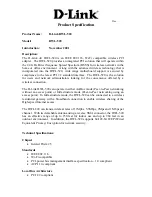
1-24
INTRODUCTION
ORBAN MODEL 1100
It is practical (though not ideal) to use lossy data reduction to pass unprocessed au-
dio to OPTIMOD-PC’s input. The data rate should be at least of “contribution qual-
ity”—the higher, the better. If any part of the studio chain is analog, we recommend
using at least 20-bit A/D conversion before encoding.
Because OPTIMOD-PC uses multiband limiting, it can dynamically change the fre-
quency response of the channel. This can violate the psychoacoustic masking as-
sumptions made in designing the lossy data reduction algorithm. Therefore, you
need to leave “headroom” in the algorithm so that OPTIMOD-PC’s multiband proc-
essing will not unmask quantization noise. This is also true of any lossy data reduc-
tion applied in the studio (such as hard disk digital delivery systems).
For MPEG Layer 2 encoding, we recommend 384kB/second or higher.
Some links may use straightforward PCM (pulse-code modulation) without lossy
data reduction. If you connect to these through an AES3 digital interface, these can
be very transparent, provided they do not truncate the digital words produced by
the devices driving their inputs and they do not require downward sample rate con-
version.
Downward sample rate conversion can cause overshoot due to spectral
truncation and asynchronous re-sampling of the 48 kHz peak-controlled
samples.
If the link does not have an AES3 input, you must drive its analog input from
OPTIMOD-PC’s monitor output. This is not recommended because OPTIMOD-PC’s
monitor output will overshoot in the analog domain because of the physics of the
system. The use of external digital-to-analog converters should also be avoided for
many of the same reasons.
Peak control in OPTIMOD-PC occurs at a 48 kHz sample frequency. This is
sufficient to prevent any samples from exceeding the threshold of limit-
ing. However, after reconstruction, the analog output may overshoot the
nominal 100% level because these overshoots “fall between the sam-
ples,” so the processing cannot be aware of them. If you use this output
to feed the analog input of a digital STL, the new samples in the STL will
not be synchronous with the samples inside OPTIMOD-PC. Therefore,
they may well fall on the overshoots, causing loss of peak modulation
control. It is thus very important to use a link with an AES3 input to en-
sure correct peak control.
The same sort of thing can happen if you use the output sample rate
converter, because the output samples are no longer synchronous with
the peak-controlled samples in the processing. Always use 48 kHz output
sample rate to achieve best peak control.
If you
must
use an analog input, you may bypass any anti-aliasing filters
in digital links driven by OPTIMOD-PC because OPTIMOD-PC’s output
spectrum is tightly controlled. This ensures the most accurate possible
transient response, given the limitations of asynchronous sampling de-
scribed above.
NICAM
is a sort of hybrid between PCM and lossy data reduction systems. It uses a
block-companded floating-point representation of the signal with J.17 preemphasis.
















































